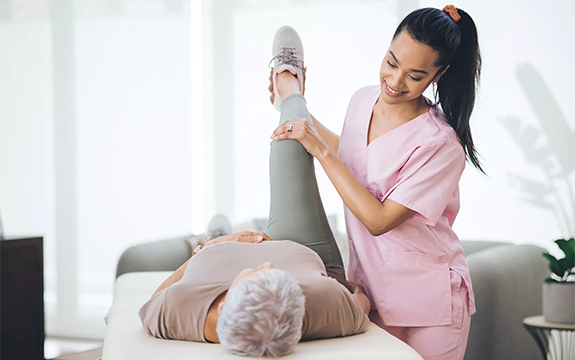As we age, our bodies undergo a natural process of decline and change. These changes can impact older adults’ physical abilities and overall quality of life. This is where geriatric physical therapy comes in.
Geriatric physical therapy, or physiotherapy for elderly patients, focuses on the unique needs and challenges older adults face. It aims to help seniors maintain or improve their functional abilities, reduce pain and discomfort, and prevent further injury or disability. At Scona Sports & Physiotherapy, we offer specialized geriatric physiotherapy services in Edmonton, tailored to meet the individual needs of our senior clients.
Why is Physiotherapy for the Elderly Important?

As we age, our bodies become more susceptible to chronic conditions such as arthritis, osteoporosis, and cardiovascular disease. These conditions can limit mobility, cause pain and discomfort, and affect overall health and well-being. Geriatric physiotherapy can help manage these conditions through targeted exercises and interventions that improve strength, balance, flexibility, and range of motion. It can also address issues related to age-related changes, such as balance and gait disturbances, decreased muscle mass, and joint stiffness.
In addition to physical benefits, geriatric physical therapy can also improve cognitive functioning in older adults. Studies have shown that regular exercise can help maintain brain health and reduce the risk of conditions like dementia and Alzheimer’s disease.
What to Expect from Geriatric Physiotherapy
At Scona Sports & Physiotherapy, we understand that each individual has unique needs and goals when it comes to their health. Our team of experienced physiotherapists will conduct a thorough assessment to identify areas of strength and weakness and any underlying conditions or injuries.
Based on the assessment, a personalized treatment plan will be created to address the specific needs of each individual. This may include a combination of exercises, manual therapy techniques, and education on proper body mechanics.
Our physiotherapists will also provide guidance and support to help seniors continue their exercises at home for long-term benefits.
Benefits of Physiotherapy for Elderly
Geriatric physical therapy offers numerous benefits for older adults, including:
- Improved mobility and balance: By targeting specific areas of weakness or injury, geriatric physical therapy can improve overall mobility and balance in seniors. This can help prevent falls and maintain independence.
- Pain relief: Chronic pain is a common issue for older adults, but with the help of physical therapy, seniors can learn exercises and techniques to manage their pain and improve their quality of life.
- Increased strength and flexibility: As we age, our muscles tend to weaken, leading to decreased strength and range of motion. Geriatric physiotherapy can help rebuild muscle mass and improve joint mobility through targeted exercises.
- Enhanced cognitive functioning: Regular exercise has been shown to positively affect brain health in older adults. By incorporating physical activity into their routine, seniors can improve their cognitive functioning and reduce their risk of developing dementia or Alzheimer’s disease.
- Improved overall health: Physical therapy can also have a positive impact on other aspects of senior health, such as cardiovascular health and bone density. Geriatric physical therapy can help seniors maintain their overall health and well-being by promoting regular exercise.
Common Conditions Treated Through Geriatric Physiotherapy
Geriatric physical therapy can help seniors manage a wide range of conditions and injuries, including:
- Arthritis: As one of the most common chronic conditions in older adults, arthritis can significantly impact mobility and quality of life. Physical therapy can help reduce pain and stiffness associated with arthritis and improve joint flexibility.
- Osteoporosis: This condition causes bones to become weak and fragile, making seniors more susceptible to fractures. Through targeted exercises, physical therapy can help slow down or even reverse bone loss in older adults.
- Stroke rehabilitation: Geriatric physical therapy is an essential part of stroke recovery for seniors. It can help improve motor skills, balance, and coordination for those who have experienced a stroke.
Falls prevention: As seniors age, their risk of falling increases. Physiotherapy for the elderly can provide exercises to improve balance, gait, and coordination to help prevent falls and reduce the risk of fall-related injuries.
Book an Appointment Today
If you or a loved one could benefit from geriatric physiotherapy, don’t hesitate to book an appointment with one of our licensed physiotherapists. We can create a personalized treatment plan to help improve seniors’ overall health and well-being. Remember, it’s never too late to start taking care of your body and promoting healthy aging through physical therapy.
